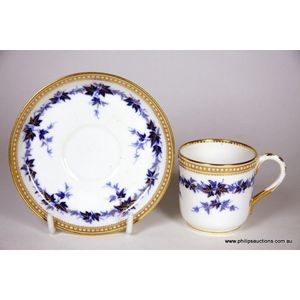18th Century Worcester Teacup & Saucer with Insects & Flowers
You must be a subscriber, and be logged in to view price and dealer details.
Subscribe Now to view actual auction price for this item
When you subscribe, you have the option of setting the currency in which to display prices to $Au, $US, $NZ or Stg.
- Manner of .... / Style of ..... - A cataloguing term where the item, in the opinion of the cataloguer is a work in the style of the artist, craftsman or designer, possibly of a later period.
- Circa - A Latin term meaning 'about', often used in the antique trade to give an approximate date for the piece, usually considered to be five years on either side of the circa year. Thus, circa 1900 means the piece was made about 1900, probably between 1895 and 1905. The expression is sometimes abbreviated to c.1900.
- Faceting - Faceting is a technique of removing material from a curved surface, to give a series of flat surfaces but retaining the profile of the original surface.
The technique is most commonly associated with diamond cutting where the various cuts used such as rose cut and brilliant cut, add life and sparkle to the stone, whilst at the same time removing as little of the stone as possible.
Faceting by grinding is also used to decorate glass. The stems of many drinking glasses are decorated by cutting a series of flat surfaces on a circular stem, and hollow vessels such as vases may have faceted surfaces.
In furniture faceting is often applied to legs of tables and chairs, where a circular baluster shaped section is flattened so as to form an octagonal section.
This item has been included into following indexes:
Visually similar items

A group of three Bunnykins Nursery wares and a Wedgwood Peter rabbit mug. Last quarter 20th century, the Bunnykins mug circa 1968-1975, the Bunnykins pieces comprising an egg cup, plate and a tapering mug, the straightsided Wedgwood mug with Beatrix Potter

An 18th century Meissen porcelain cup and saucer with finely painted fruit and floral decoration and gilt lace border. C.1740. Width 13.5 cm

A Royal Worcester demitasse cup and saucer, 1878, pattern B 379, with trailing borders of dark and light blue ivy and gilded highlights with jewelled borders upon a white ground; with puce backstamp, pattern number and decorator's mark underside. Height 5.

A Dr Wall Worcester 'Chinese Family' tea bowl and saucer, circa 1770, a delightful petite bowl and conforming saucer with crow's foot red and gold borders and decorated in a polychrome palette with narrative scenes comprising pairs of male and female figur
